KIN 312 Exam #2
1/103
Earn XP
Description and Tags
KIN 312 - CSULB
Name | Mastery | Learn | Test | Matching | Spaced |
|---|
No study sessions yet.
104 Terms
Performance Outcome Measures
Measures the results or outcome of a skill. Ex: Distance thrown, speed, reaction time.
Performance Production Measures
Informs us about how the nervous system, muscular system, and limbs are acting to produce the performance outcome. Ex: EEG, EMG, force, limb kinematics.
Reaction Time
Indicates how long it takes to prepare & initiate movement.

Movement Time
The interval of time between the initiation of a movement and the completion of the movement.
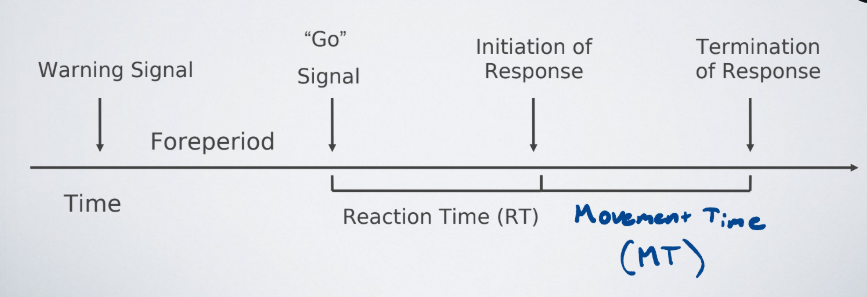
Response Time
The time interval involving both the reaction time and the movement time; the time from the onset of a signal to the completion of a response.

Simple Reaction Time
The reaction time that involves 1 signal or stimulus and 1 response.

Choice Reaction Time
The reaction time that involves more than one signal and each requires it’s own specified response.

Discrimination Reaction Time
The reaction time that involves more than one signal but only one response, which is to only one of the signals; the other signals require no response.
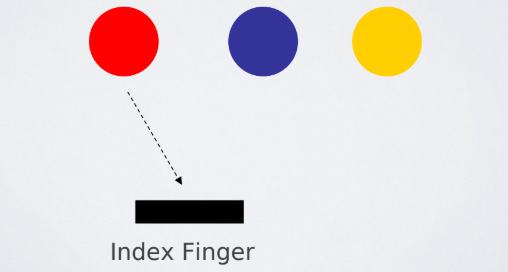
True or False: Reaction time does not predict movement time.
True
True or False: Movement time does not predict reaction time.
True
True or False: Individuals may have differing rates of both reaction and movement time.
True
Premotor Time (PRMOT)
Time that elapses between the presentation of a stimulus and the first change in EMG activity.

Motor Time (MOT)
Begins with the first change in EMG activity and ends when movement begins.

What two time periods or intervals allow researches to identify changes in movement reaction time are due to cognitive processes or mechanical features of the limb?
Premotor Time (PRMOT) & Motor Time (MOT)
Absolute Error
A measure of error without regard to direction. Typically 1-Dimensional.
Constant Error
A measure of error with direction. A signed deviation from the target. Typically 1-Dimensional.
Variable Error
A error score that represents the variability of performance; the standard deviation of a series of constant scores.
Foreperiod
The time interval between the warning signal and “go” signal.
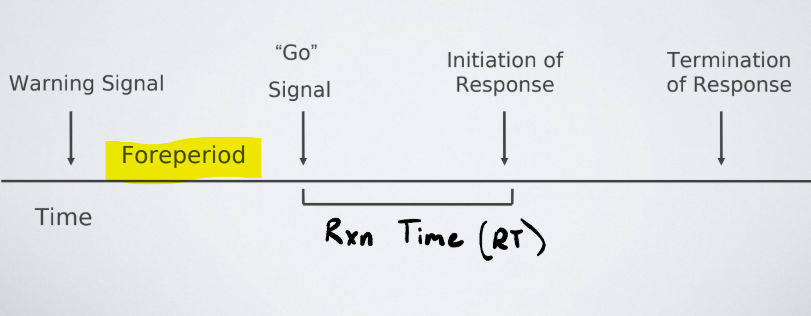
Radial Error
An error measure for 2-dimensional actions. Measures the distance from the target in a two dimensional space. Can be calculated when given a vertical and horizontal error. Based off basic right triangle trigonometry.
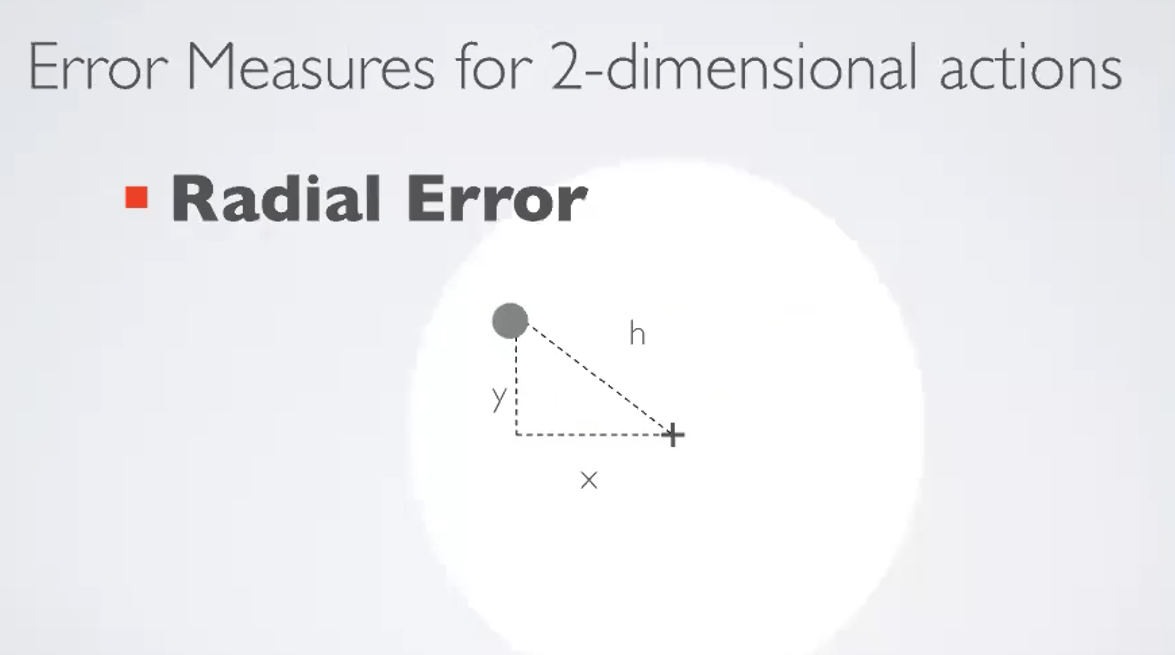
Root-mean-squared error (RMSE)
Indicates the amount of error between the performance curve produced and the criterion performance curve for a specific amount of time.
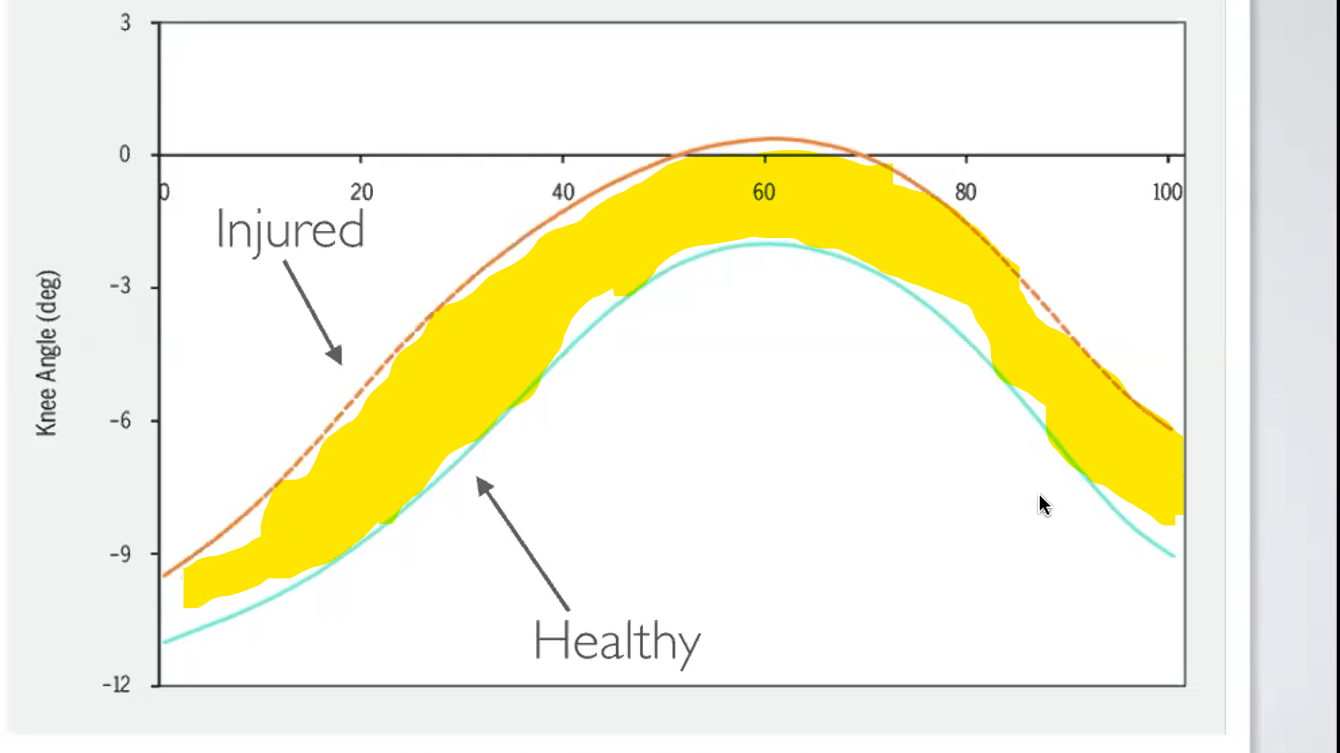
Kinematics
The description of motion without regard to force or mass; displacement, velocity, acceleration.
Displacement
Describes changes in spatial location as a person carries out a movement.
Velocity
Rate of change in an object position with respect to time.
Acceleration
Change in velocity during movement.
Kinetics
Refers to force as the cause of motion.
When using a force plate or strain gauge, what is being measured, kinetics or kinematics?
Kinetics
Electromyography (EMG)
Measures the electrical activity in muscles.
Electroencephalography
Measures brain activity
Positron Emission Tomography (PET)
Used for measuring the concentration of positron emitting radioisotopes within different body tissues.
Functional Magnetic Resonance Imaging (fMRI)
Visualizes brain function through change in fluid flow (cerebrospinal fluid, blood).
Lesions
Removed portion of brain matter to see effects on function (performed on lab animals).
Action preparation (Reaction Time)
involves the events that occur in the nervous system from the intention of an action to the initiation of an action.
What is step #1 of planning the action at the cognitive level?
Making the decision to act.
Making the decision to act - Action preparation or planning begins with a decision or _______.
intention to act.
Acts maybe driven by ________ or _________.
Internal goals, response to the environment.
What is step #2 of planning the action at the cognitive level?
Developing a general plan.
Developing a general plan or determining how appropriate the action plan is for the situation is determined by _________ and _________:
Previous experience, evaluation of the situation.
What is step #3 of planning the action at the cognitive level?
Adding details to the plan.
Selecting various movement parameters (force, velocity, displacement).
Which body part will be used.
What environmental characteristics are present.
Is darts an example of a motor act driven by the environment or internal goals?
Internal goals
Is hitting a ball an example of a motor act driven by the environment or internal goals?
The environment
Hicks Law Formula
RT = Klog(N+1)
K = simple RT
N = number of choices
Hicks Law
As the number of choices increase, so does the reaction time.
Absolute Value Formula
∑ |xi - T|/N
Constant Error Formula
∑ (xi - T)/N
Variable Error Formula
(∑ (xi - CE)2)/(N-1)
The Predictability of the Correct Response Choice
As the predictability of one of the choices increases, reaction time decreases.
Influence of Precue Correctness
Precue correctness is how we're looking at clues in the environment to tell us what's going to happen.
50/50 chance of correct precue: no preference
80/20 chance of correct precue: bias toward the higher probability.
Stimulus-Response Compatibility
Reaction time will be faster if the relationship between the stimulus and response are compatible. Ex: The button layout on a remote, the UI of a phone application. Stroop effect highlights this concept.
Foreperiod Length Regularity
If the foreperiod is the same for every simple reaction time task, reaction time will decrease.
If the foreperiod is the same for every simple reaction time task, reaction time will _______.
Decrease
What are the 8 task influences of preparation?
The Number of Response Choices (Hicks Law)
The Predictability of the Correct Response Choice
Influence of Precue Correctness
Stimulus-Response Compatibility
Foreperiod Length Regularity
Movement Complexity
Movement Accuracy
Repetitions of Movement
Reaction time increases as a function of the number of component parts in a movement _____.
increases
As the accuracy of the demand for a movement increases the amount of preparation time _______.
increases
When the performer is alert and attentive, initiation time is _____.
reduced
Reaction time is ________ when performers focus on a signal rather than a movement or set of movements.
reduced
What 4 areas in the CNS are associated with planning and execution of actions?
Limbic System
Association Cortex
Projection System
Spinal System
What are the two influences of the performer on initiation?
Alertness of Performer
Attentional Focus of Performer
Structure that surrounds the hypothalamus.
The limbic system
Responsible for our intention to act according to environmental demands.
The limbic system
The Fornix, Amygdala, Hippocampus, Cingulate, and Gyrus are all part of what?
The limbic system
Distributed throughout the cortex.
The association cortex
Analyzes and transforms acts that are generated in the limbic system into general plans of action.
The association cortex
What recognizes, selects, and integrates relevant sensory input when planning an action?
The association cortex
Determines how the action should be carried out.
The projection system
Responsible for adding the movement dynamics to best fit the goal and environmental constraints.
The projection system
Regulates the timing of the muscle activation patterns; is the “fine tuner” of the systems.
The spinal system
True or False: Information flowing within the systems is unidirectional.
False, information flowing within the systems is NOT unidirectional.
True or False: Feedback loops between the systems allow the CNS to make modifications.
True
True or False: Modifications made between the systems are based on comparisons between the action produced and the goal action.
True
What neuromotor level matches up with the cognitive level: step #2 - developing a general plan?
The association cortex
What neuromotor level matches up with the cognitive level: step #1 - Making the decision to act?
The limbic system
What two neuromotor levels match up with the cognitive level: step #3 - adding details to the plan?
The projection system and spinal system
Definition of Attention
The engagement in perceptual, cognitive, and motor activities before, during, and after performing motor skills.
True or False: We can consciously or non-consciously engage in attention activities.
True
What are the three types of conscious attention?
Perceptual attention
Cognitive attention
Motor attention
“I’m looking at…”
Perceptual attention
“I am thinking about”
Cognitive attention
“I am moving…”
Motor attention
Is able to verbally describe the attention activity.
Conscious engagement
Cannot, or have difficultly, verbally describing the attention activity.
Non-conscious engagement
A key factor that influences the amount of activities people can perform simultaneously.
Limited attention capacity
Theory that explains how there is “one supply store” from which all attention activities must be obtained.
Central Resource Theory
View that attention is always the same amount; attention stays constant.
Fixed
View that attention capacity varies from situation to situation.
Flexible
A flexible central resource theory. States that flexible amounts of attention are due to arousal levels.
Kahneman’s Theory
Excitability of a person, emotional, mental, and physiological states.
Arousal level
According to Kahneman’s Theory, what is the factor that influences the amount of attention capacity available for a specific performance situation?
Arousal level
According to Kahneman’s Theory, maximum attention capacity equals…
Optimum arousal level for the situation.
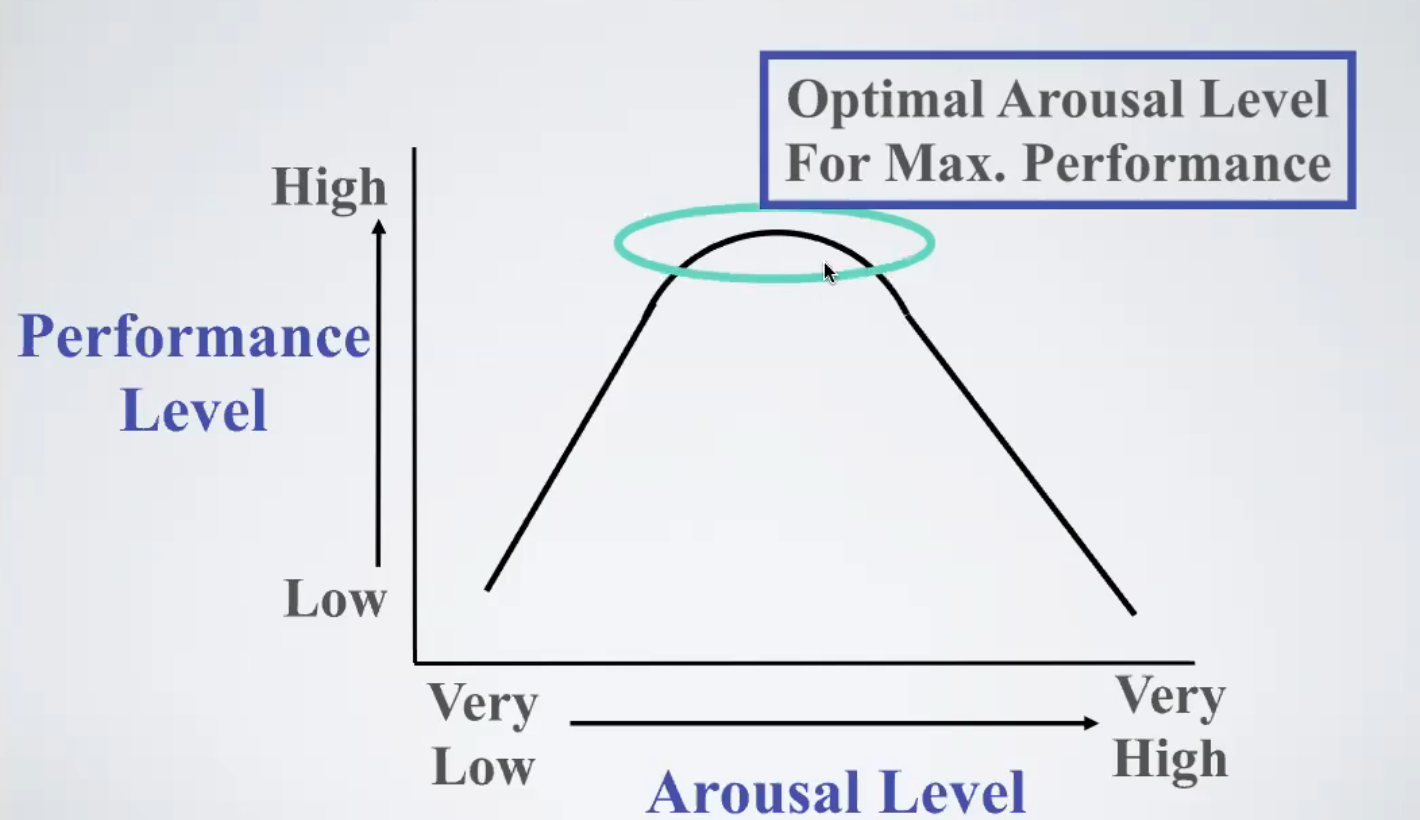
What is the relationship between the performance and arousal levels according to Kahneman’s Theory? hint: think shapes
Inverted “U” relationship
True or False: Task demands are stagnant when learning a skill.
False, task demands change with learning a skill.
True or False: Demands are task specific.
True
What are the two types of attention allocation policies?
Enduring dispositions
Momentary intentions
When you hear your name when talking to someone, you invertedly look around you. What type of attention allocation policy is this?
Enduring dispositions
Involuntary allocation of attention
Enduring dispositions
An intentional allocation of attention
Momentary intentions
A coach tells their player to concentrate on something and the player attempts to do so. What attention allocation policy is this?Momentary intentions
Proposed by Wickens (1980, 1992)
Multiple Resources Theory
According to Multiple Resources Theory, resources are available from what 3 sources?
Input/Output Modalities (vision, speech)
Stages of Information Processing (perception, memory encoding, response output)
Codes of processing information (verbal and spatial codes).
Theory that states that the different kinds of attention we allocate come from different places.
Multiple Resources Theory
A procedure to assess attention demands of performing a motor skill. Person instructed to maintain normal performance on primary task. Secondary task performance assessed to determine attention demands of the primary task.
Dual Task Procedure